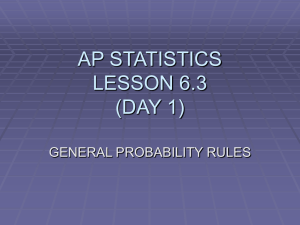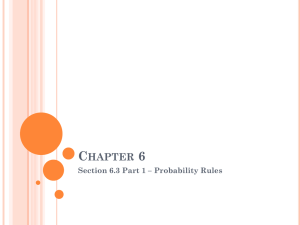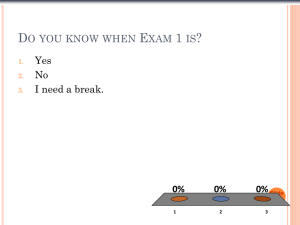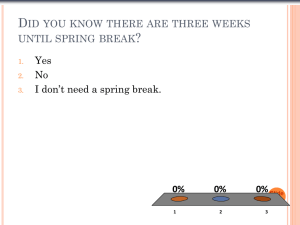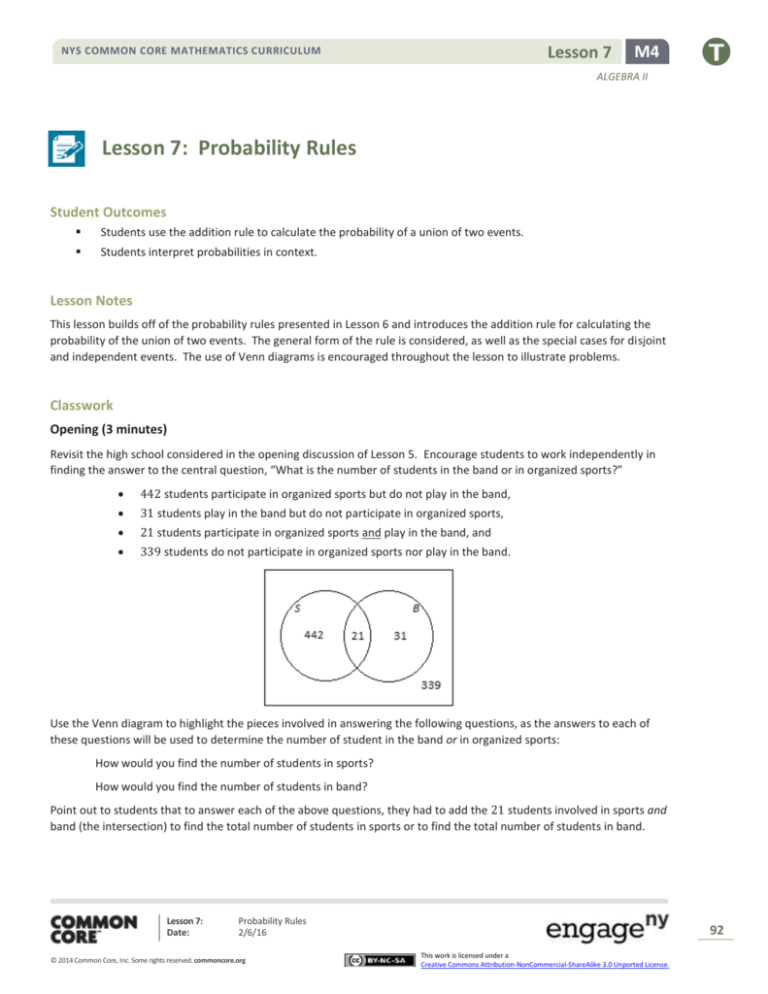
Lesson 7
NYS COMMON CORE MATHEMATICS CURRICULUM
M4
ALGEBRA II
Lesson 7: Probability Rules
Student Outcomes
Students use the addition rule to calculate the probability of a union of two events.
Students interpret probabilities in context.
Lesson Notes
This lesson builds off of the probability rules presented in Lesson 6 and introduces the addition rule for calculating the
probability of the union of two events. The general form of the rule is considered, as well as the special cases for disjoint
and independent events. The use of Venn diagrams is encouraged throughout the lesson to illustrate problems.
Classwork
Opening (3 minutes)
Revisit the high school considered in the opening discussion of Lesson 5. Encourage students to work independently in
finding the answer to the central question, “What is the number of students in the band or in organized sports?”
442 students participate in organized sports but do not play in the band,
31 students play in the band but do not participate in organized sports,
21 students participate in organized sports and play in the band, and
339 students do not participate in organized sports nor play in the band.
Use the Venn diagram to highlight the pieces involved in answering the following questions, as the answers to each of
these questions will be used to determine the number of student in the band or in organized sports:
How would you find the number of students in sports?
How would you find the number of students in band?
Point out to students that to answer each of the above questions, they had to add the 21 students involved in sports and
band (the intersection) to find the total number of students in sports or to find the total number of students in band.
Lesson 7:
Date:
Probability Rules
2/6/16
© 2014 Common Core, Inc. Some rights reserved. commoncore.org
92
This work is licensed under a
Creative Commons Attribution-NonCommercial-ShareAlike 3.0 Unported License.
Lesson 7
NYS COMMON CORE MATHEMATICS CURRICULUM
M4
ALGEBRA II
Discuss how the number of students in band or sports would be calculated if the
summary of the school was presented differently. In particular, discuss with
students how they would determine the number of students in band or sports if
the description of the school were the following:
463 students are in sports,
52 students are in the band, and
21 students are in both sports and band.
The number of students in sports or the number of students in band (called the
union) is 463 + 52 − 21. The piece representing students in band and sports (or
the intersection) is part of the total number of students in band, and it is also part
of the total number of students in sports. As a result, if the number of students
in band (52) and the number of students in sports (463) are added together, the
21 students in both band and sports are counted twice. As indicated, it is
necessary to subtract the 21 students in both band and sports to make sure that
these students are counted only once. Generalizing this as a probability of the
union of two overlapping events is the focus of this lesson.
Exercise 1 (9 minutes)
Scaffolding:
For advanced learners, ask students to
draw a Venn diagram to illustrate this
scenario and determine how many
students are in sports or in the band.
For students who are struggling, use the
Venn diagram below to illustrate this
scenario:
S: 463
B: 52
Scaffolding:
Introduce the following addition rule to students. (This rule was informally
illustrated with the above example and in several questions in the earlier lessons
with two-way frequency tables.) The addition rule states that for any two events
𝐴 and 𝐵,
𝑃(𝐴 or 𝐵) = 𝑃(𝐴) + 𝑃(𝐵) − 𝑃(𝐴 and 𝐵).
To illustrate, draw a Venn diagram, denoting the probabilities of events as shown.
For students that may be struggling with
this concept, consider displaying and
discussing several concrete examples in
conjunction with the abstract
representation.
For example, using the case of a coin
flip, with 𝐴 = heads and 𝐵 = tails:
𝑃(𝐴 or 𝐵) = 𝑃(𝐴) + 𝑃(𝐵)
− 𝑃(𝐴 and 𝐵)
1 = 0.5 + 0.5 − 0
(Note: 𝑝 = 𝑃(𝐴 and not 𝐵), 𝑞 = 𝑃(𝐴 and 𝐵), and 𝑟 = 𝑃(𝐵 and not 𝐴), but the
labeling of the Venn diagram should be sufficient to communicate this.)
Therefore, 𝑃(𝐴) + 𝑃(𝐵) − 𝑃(𝐴 and 𝐵) = (𝑝 + 𝑞) + (𝑞 + 𝑟) − 𝑞
= 𝑝 + 𝑞 + 𝑟
= 𝑃(𝐴 or 𝐵)
Indicate to students that 𝑃(𝐴 or 𝐵) 𝑖𝑠 𝑝 + 𝑞 + 𝑟 using the Venn diagram directly.
Note that when the probability of the events 𝐴 or 𝐵 were added together, the
Lesson 7:
Date:
Discuss the meaning of each component
of the equation in context (e.g., 1 makes
sense in this situation because we are
certain that the coin will either land on
heads or tails; 0 makes sense because it
could not land on both heads and tails
in one flip).
For students that may be above grade
level, consider encouraging them to
determine the addition rule
independently by asking, "What is a
general rule for determining 𝑃(𝐴 or 𝐵)?
Use the example from the opening to
determine your answer.”
Probability Rules
2/6/16
© 2014 Common Core, Inc. Some rights reserved. commoncore.org
93
This work is licensed under a
Creative Commons Attribution-NonCommercial-ShareAlike 3.0 Unported License.
Lesson 7
NYS COMMON CORE MATHEMATICS CURRICULUM
M4
ALGEBRA II
probability of 𝑞 was added twice; therefore, the addition rule indicates that 𝑞 (the intersection) is subtracted from the
sum of the two events to make sure it is not added twice.
Exercise 1 is a straightforward application of the addition rule. Since Exercise 1 and 2 are students’ first experience using
the addition rule, consider having students work in pairs. Use this as an opportunity to informally assess student
understanding of the addition rule.
Exercise 1
When a car is brought to a repair shop for a service, the probability that it will need the transmission fluid replaced is
𝟎. 𝟑𝟖, the probability that it will need the brake pads replaced is 𝟎. 𝟐𝟖, and the probability that it will need both the
transmission fluid and the brake pads replaced is 𝟎. 𝟏𝟔. Let the event that a car needs the transmission fluid replaced be
𝑻 and the event that a car needs the brake pads replaced be 𝑩.
a.
b.
What are the values of
i.
𝑷(𝑻)
𝟎. 𝟑𝟖
ii.
𝑷(𝑩)
0.28
iii.
𝑷(𝑻 and 𝑩)
0.16
Use the addition rule to find the probability that a randomly selected car needs the transmission fluid or the brake
pads replaced.
𝑷(𝑻 or 𝑩) = 𝑷(𝑻) + 𝑷(𝑩) − 𝑷(𝑻 and 𝑩) = 𝟎. 𝟑𝟖 + 𝟎. 𝟐𝟖 − 𝟎. 𝟏𝟔 = 𝟎. 𝟓
Exercise 2 (5 minutes)
Here students are asked to use the addition rule in conjunction with the multiplication rule for independent events.
Exercise 2
Josie will soon be taking exams in math and Spanish. She estimates that the probability she passes the math exam is 𝟎. 𝟗
and the probability that she passes the Spanish exam is 𝟎. 𝟖. She is also willing to assume that the results of the two
exams are independent of each other.
a.
Using Josie’s assumption of independence, calculate the probability that she passes both exams.
𝑷(passes both) = (𝟎. 𝟗)(𝟎. 𝟖) = 𝟎. 𝟕𝟐
b.
Find the probability that Josie passes at least one of the exams. (Hint: Passing at least one of the exams is passing
math or passing Spanish.)
𝑷(passes math or Spanish) = 𝑷(passes math) + 𝑷(passes Spanish)– 𝑷(passes both)
= 𝟎. 𝟗 + 𝟎. 𝟖 − 𝟎. 𝟕𝟐 = 𝟎. 𝟗𝟖
Example 1 (7 minutes): Use of the Addition Rule for Disjoint Events
Introduce the idea of disjoint events and how the addition rule for disjoint events is different than the addition rule for
events that had an intersection. As you discuss the following examples with students, ask them how these events differ
from the previous examples.
An animal hospital has 5 dogs and 3 cats out of 10 animals in the hospital. What is the probability that an
animal selected at random is a dog or a cat?
Lesson 7:
Date:
Probability Rules
2/6/16
© 2014 Common Core, Inc. Some rights reserved. commoncore.org
94
This work is licensed under a
Creative Commons Attribution-NonCommercial-ShareAlike 3.0 Unported License.
Lesson 7
NYS COMMON CORE MATHEMATICS CURRICULUM
M4
ALGEBRA II
At a certain high school, 100 students are involved in an afterschool community service program. Students
can only sign up for one project. Currently, 25 students are involved in cleaning up nearby parks, 20 students
are tutoring elementary students in mathematics, and the rest of the students are working at helping out at a
community recreational center. What is the probability that a randomly selected student is involved in
cleaning up nearby parks or tutoring elementary students in mathematics?
The above examples are different in that they do not have any students in the intersection. Students would indicate that
the addition rule of two events would not have a piece that needs to be subtracted. The probability of randomly
selecting a dog or a cat is
5
10
+
3
. The probability of randomly selecting a student involved in cleaning a nearby park or
10
tutoring elementary students in mathematics is
25
100
+
20
100
.
Summarize the following with students:
Two events are said to be disjoint if they have no outcomes in common. So if the events 𝐴 and 𝐵 are disjoint, the
Venn diagram looks like this
Another way of describing disjoint events is by saying that they cannot both happen at the
same time. Continue discussing with students other examples.
If a number cube has faces numbered 1–6, and the number cube is rolled once, then the
events the result is even and the result is a 5 are disjoint (since “even” and “5” cannot
both happen on a single roll), but the events the result is even and the result is greater
than 4 are not (since getting a 6 results in both events occurring).
It would be a good idea at this stage to provide some other examples of disjoint and nondisjoint events so that students get used to the meaning of the term.
Scaffolding:
Point out to students that the
meaning of disjoint can be
found by examining the prefix
“dis” and the word “joint.”
Remind students that “dis”
means “not.” The stem "joint"
has several other meanings
that might need to be
explained or explored.
If 𝐴 and 𝐵 are disjoint, then 𝑃(𝐴 and 𝐵) = 0. So, the addition rule for disjoint events can be written as
𝑃(𝐴 or 𝐵) = 𝑃(𝐴) + 𝑃(𝐵).
Now work through the example presented in the lesson as a class. This is a straightforward application of the addition
rule for disjoint events.
Lesson 7:
Date:
Probability Rules
2/6/16
© 2014 Common Core, Inc. Some rights reserved. commoncore.org
95
This work is licensed under a
Creative Commons Attribution-NonCommercial-ShareAlike 3.0 Unported License.
Lesson 7
NYS COMMON CORE MATHEMATICS CURRICULUM
M4
ALGEBRA II
Example 1: Use of the Addition Rule for Disjoint Events
A set of 𝟒𝟎 cards consists of
𝟏𝟎 black cards showing squares.
𝟏𝟎 black cards showing circles.
𝟏𝟎 red cards showing Xs.
𝟏𝟎 red cards showing diamonds.
A card will be selected at random from the set. Find the probability that the card is black or shows a diamond.
The events “is black” and “shows a diamond” are disjoint since there are no black cards that show diamonds. So,
𝑷(black or diamond) = 𝑷(black) + 𝑷(diamond)
𝟐𝟎 𝟏𝟎
+
𝟒𝟎 𝟒𝟎
𝟑𝟎 𝟑
=
=
𝟒𝟎 𝟒
=
Example 2 (4 minutes): Combining Use of the Multiplication and Addition Rules
The addition rule for disjoint events is often used in conjunction with the multiplication rule for independent events.
This example illustrates this.
When tackling part (b), point out to students that the three events—red shows 6 and blue shows 5, red shows 5 and
blue shows 6, red shows 6 and blue shows 6—are disjoint. This is why the probabilities are added together.
Example 2: Combining Use of the Multiplication and Addition Rules
A red cube has faces labeled 𝟏 through 𝟔, and a blue cube has faces labeled in the same way. The two cubes are rolled.
Find the probability that
a.
both cubes show 𝟔s.
𝑷(red shows 𝟔 and blue shows 𝟔) = 𝑷(red shows 𝟔)𝑷(blue shows 𝟔) =
b.
𝟏 𝟏
𝟏
∙ =
𝟔 𝟔 𝟑𝟔
the total score is at least 𝟏𝟏.
𝑷(total is at least 𝟏𝟏)
= 𝑷(red shows 𝟔 and blue shows 𝟓) + 𝑷(red shows 𝟓 and blue shows 𝟔)
+ 𝑷(red shows 𝟔 and blue shows 𝟔)
𝑷(total is at least 𝟏𝟏) =
𝟏 𝟏 𝟏 𝟏 𝟏 𝟏
𝟏
𝟏
𝟏
𝟏
∙ + ∙ + ∙ =
+
+
=
𝟔 𝟔 𝟔 𝟔 𝟔 𝟔 𝟑𝟔 𝟑𝟔 𝟑𝟔 𝟏𝟐
Exercise 3 (7 minutes)
This exercise provides additional practice with the ideas introduced in Example 2. Part (c) is a little more complex than
any part of Example 2, and part (d) requires the students to recall the complement rule. Have students first work the
solutions independently. Then have students compare and discuss solutions with a partner. Ask students to describe
MP.1
and compare with each other how they found their solution. This is an opportunity for students to show persistence in
solving a problem.
Lesson 7:
Date:
Probability Rules
2/6/16
© 2014 Common Core, Inc. Some rights reserved. commoncore.org
96
This work is licensed under a
Creative Commons Attribution-NonCommercial-ShareAlike 3.0 Unported License.
Lesson 7
NYS COMMON CORE MATHEMATICS CURRICULUM
M4
ALGEBRA II
Exercise 3
The diagram above shows two spinners. For the first spinner, the scores 𝟏, 𝟐, and 𝟑 are equally likely, and for the second
spinner, the scores 𝟏, 𝟐, 𝟑, and 𝟒 are equally likely. Both pointers will be spun. Writing your answers as fractions in
lowest terms, find the probability that
a.
the total of the scores on the two spinners is 𝟐.
𝑷(total = 𝟐) = 𝑷(𝟏, 𝟏) =
b.
𝟏 𝟏
𝟏
∙ =
𝟑 𝟒 𝟏𝟐
the total of the scores on the two spinners is 𝟑.
𝑷(total = 𝟑) = 𝑷(𝟏, 𝟐) + 𝑷(𝟐, 𝟏) =
c.
𝟏 𝟏 𝟏 𝟏
𝟏
𝟏
𝟐
𝟏
∙ + ∙ =
+
=
=
𝟑 𝟒 𝟑 𝟒 𝟏𝟐 𝟏𝟐 𝟏𝟐 𝟔
the total of the scores on the two spinners is 𝟓.
𝑷(total = 𝟓) = 𝑷(𝟏, 𝟒) + 𝑷(𝟐, 𝟑) + 𝑷(𝟑, 𝟐)
𝟏 𝟏 𝟏 𝟏 𝟏 𝟏
∙ + ∙ + ∙
𝟑 𝟒 𝟑 𝟒 𝟑 𝟒
𝟏
𝟏
𝟏
=
+
+
𝟏𝟐 𝟏𝟐 𝟏𝟐
𝟑
=
𝟏𝟐
𝟏
=
𝟒
=
d.
the total of the scores on the two spinners is not 𝟓.
𝑷(total is not 𝟓) = 𝟏 − 𝑷(total is 𝟓) = 𝟏 −
𝟏 𝟑
=
𝟒 𝟒
Closing (3 minutes)
Review the difference between independent and disjoint events. Ask students to define each.
Two events are independent if knowing that one event has occurred does not change the probability
that the other event has occurred. Two events are said to be disjoint if they have no outcomes in
common.
Lesson 7:
Date:
Probability Rules
2/6/16
© 2014 Common Core, Inc. Some rights reserved. commoncore.org
97
This work is licensed under a
Creative Commons Attribution-NonCommercial-ShareAlike 3.0 Unported License.
Lesson 7
NYS COMMON CORE MATHEMATICS CURRICULUM
M4
ALGEBRA II
Ask students to summarize the main ideas of the lesson in writing or with a neighbor. Use this as an opportunity to
informally assess comprehension of the lesson. The Lesson Summary below offers some important ideas that should be
included.
Lesson Summary
The addition rule states that for any two events 𝑨 and 𝑩, 𝑷(𝑨 or 𝑩) = 𝑷(𝑨) + 𝑷(𝑩) − 𝑷(𝑨 and 𝑩).
The addition rule can be used in conjunction with the multiplication rule for independent events: Events 𝑨 and 𝑩
are independent if and only if 𝑷(𝑨 and 𝑩) = 𝑷(𝑨)𝑷(𝑩).
Two events are said to be disjoint if they have no outcomes in common. If 𝑨 and 𝑩 are disjoint events, then
𝑷(𝑨 or 𝑩) = 𝑷(𝑨) + 𝑷(𝑩).
The addition rule for disjoint events can be used in conjunction with the multiplication rule for independent events.
Exit Ticket (7 minutes)
Lesson 7:
Date:
Probability Rules
2/6/16
© 2014 Common Core, Inc. Some rights reserved. commoncore.org
98
This work is licensed under a
Creative Commons Attribution-NonCommercial-ShareAlike 3.0 Unported License.
Lesson 7
NYS COMMON CORE MATHEMATICS CURRICULUM
M4
ALGEBRA II
Name ___________________________________________________
Date____________________
Lesson 7: Probability Rules
Exit Ticket
1.
2.
When a call is received at an airline’s call center, the probability that it comes from abroad is 0.32, and the
probability that it is to make a change to an existing reservation is 0.38.
a.
Suppose that you are told that the probability that a call is both from abroad and is to make a change to an
existing reservation is 0.15. Calculate the probability that a randomly selected call is either from abroad or is
to make a change to an existing reservation.
b.
Suppose now that you are not given the information in part (a), but you are told that the events the call is from
abroad and the call is to make a change to an existing reservation are independent. What is now the
probability that a randomly selected call is either from abroad or is to make a change to an existing
reservation?
A golfer will play two holes of a course. Suppose that on each hole the player will score 3, 4, 5, 6, or 7, with these
five scores being equally likely. Find the probability, and explain how the answer was determined that the player’s
total score for the two holes will be
a.
14.
b.
12.
Lesson 7:
Date:
Probability Rules
2/6/16
© 2014 Common Core, Inc. Some rights reserved. commoncore.org
99
This work is licensed under a
Creative Commons Attribution-NonCommercial-ShareAlike 3.0 Unported License.
Lesson 7
NYS COMMON CORE MATHEMATICS CURRICULUM
M4
ALGEBRA II
Exit Ticket Sample Solutions
1.
When a call is received at an airline’s call center, the probability that it comes from abroad is 𝟎. 𝟑𝟐, and the
probability that it is to make a change to an existing reservation is 𝟎. 𝟑𝟖.
a.
Suppose that you are told that the probability that a call is both from abroad and is to make a change to an
existing reservation is 𝟎. 𝟏𝟓. Calculate the probability that a randomly selected call is either from abroad or is
to make a change to an existing reservation.
𝑷(abroad or change) = 𝑷(abroad) + 𝑷(change) − 𝑷(abroad and change)
= 𝟎. 𝟑𝟐 + 𝟎. 𝟑𝟖 – 𝟎. 𝟏𝟓
= 𝟎. 𝟓𝟓
b.
Suppose now that you are not given the information in part (a), but you are told that the events the call is
from abroad and the call is to make a change to an existing reservation are independent. What is now the
probability that a randomly selected call is either from abroad or is to make a change to an existing
reservation?
𝑷(abroad and change) = 𝑷(abroad)𝑷(change)
= (𝟎. 𝟑𝟐)(𝟎. 𝟑𝟖)
= 𝟎. 𝟏𝟐𝟏𝟔
So,
𝑷(abroad or change) = 𝑷(abroad) + 𝑷(change) − 𝑷(abroad and change)
= 𝟎. 𝟑𝟐 + 𝟎. 𝟑𝟖 – 𝟎. 𝟏𝟐𝟏𝟔
= 𝟎. 𝟓𝟕𝟖𝟒
2.
A golfer will play two holes of a course. Suppose that on each hole the player will score 𝟑, 𝟒, 𝟓, 𝟔, or 𝟕, with these
five scores being equally likely. Find the probability and explain how the answer was determined that the player’s
total score for the two holes will be
a.
𝟏𝟒.
The only way to have a total score of 𝟏𝟒 is if the player scores 7 on each hole or 𝑷(𝟕, 𝟕). Each of the scores is
equally likely, so 𝑷(𝟕) =
𝟏
= 𝟎. 𝟐.
𝟓
𝑷(total = 𝟏𝟒) = 𝑷(𝟕, 𝟕) = (𝟎. 𝟐)(𝟎. 𝟐) = 𝟎. 𝟎𝟒
b.
𝟏𝟐.
There are three ways to have a total score of 𝟏𝟐. The player could score 𝟕 on the first hole and 𝟓 on the
second. The player could score 𝟔 on the first hole and 𝟔 on the second. Finally the player could score 𝟓 on
the first hole and 𝟕 on the second. Again, all of the scores are equally likely so 𝑷(𝟓) = 𝑷(𝟔) = 𝑷(𝟕) =
𝟏
=
𝟓
𝟎. 𝟐.
𝑷(total = 𝟏𝟐) = 𝑷(𝟕, 𝟓) + 𝑷(𝟔, 𝟔) + 𝑷(𝟓, 𝟕)
= (𝟎. 𝟐)(𝟎. 𝟐) + (𝟎. 𝟐)(𝟎. 𝟐) + (𝟎. 𝟐)(𝟎. 𝟐)
= 𝟎. 𝟎𝟒 + 𝟎. 𝟎𝟒 + 𝟎. 𝟎𝟒
= 𝟎. 𝟏𝟐
Lesson 7:
Date:
Probability Rules
2/6/16
© 2014 Common Core, Inc. Some rights reserved. commoncore.org
100
This work is licensed under a
Creative Commons Attribution-NonCommercial-ShareAlike 3.0 Unported License.
Lesson 7
NYS COMMON CORE MATHEMATICS CURRICULUM
M4
ALGEBRA II
Problem Set Sample Solutions
1.
Of the works of art at a large gallery, 𝟓𝟗% are paintings and 𝟖𝟑% are for sale. When a work of art is selected at
random, let the event that it is a painting be 𝑨 and the event that it is for sale be 𝑩.
a.
What are the values of 𝑷(𝑨) and 𝑷(𝑩)?
𝑷(𝑨) = 𝟎. 𝟓𝟗, 𝑷(𝑩) = 𝟎. 𝟖𝟑
b.
Suppose you are told that 𝑷(𝑨 and 𝑩) = 𝟎. 𝟓𝟏. Find 𝑷(𝑨 or 𝑩).
𝑷(𝑨 or 𝑩) = 𝑷(𝑨) + 𝑷(𝑩) − 𝑷(𝑨 and 𝑩) = 𝟎. 𝟓𝟗 + 𝟎. 𝟖𝟑 − 𝟎. 𝟓𝟏 = 𝟎. 𝟗𝟏
c.
Suppose now that you are not given the information in part (b), but you are told that the events 𝑨 and 𝑩 are
independent. Find 𝑷(𝑨 or 𝑩).
𝑷(𝑨 and 𝑩) = 𝑷(𝑨)𝑷(𝑩) = (𝟎. 𝟓𝟗)(𝟎. 𝟖𝟑) = 𝟎. 𝟒𝟖𝟗𝟕.
So, 𝑷(𝑨 or 𝑩) = 𝑷(𝑨) + 𝑷(𝑩) − 𝑷(𝑨 and 𝑩) = 𝟎. 𝟓𝟗 + 𝟎. 𝟖𝟑 − 𝟎. 𝟒𝟖𝟗𝟕 = 𝟎. 𝟗𝟑𝟎𝟑.
2.
A traveler estimates that, for an upcoming trip, the probability of catching malaria is 𝟎. 𝟏𝟖, the probability of
catching typhoid is 𝟎. 𝟏𝟑, and the probability of catching neither of the two diseases is 𝟎. 𝟕𝟓.
a.
Draw a Venn diagram to represent this information.
b.
Calculate the probability of catching both of the diseases.
𝑷(𝑴 or 𝑻) = 𝟏 − 𝟎. 𝟕𝟓 = 𝟎. 𝟐𝟓.
By the addition rule, 𝑷(𝑴 or 𝑻) = 𝑷(𝑴) + 𝑷(𝑻) − 𝑷(𝑴 and 𝑻),
so 𝟎. 𝟐𝟓 = 𝟎. 𝟏𝟖 + 𝟎. 𝟏𝟑 − 𝑷(𝑴 and 𝑻),
so 𝟎. 𝟐𝟓 = 𝟎. 𝟑𝟏 − 𝑷(𝑴 and 𝑻),
so 𝑷(𝑴 and 𝑻) = 𝟎. 𝟎𝟔.
c.
Are the events catches malaria and catches typhoid independent? Explain your answer.
𝑷(𝑴 and 𝑻) = 𝟎. 𝟎𝟔.
𝑷(𝑴)𝑷(𝑻) = (𝟎. 𝟏𝟖)(𝟎. 𝟏𝟑) = 𝟎. 𝟎𝟐𝟑𝟒.
Since these quantities are different, the two events are not independent.
Lesson 7:
Date:
Probability Rules
2/6/16
© 2014 Common Core, Inc. Some rights reserved. commoncore.org
101
This work is licensed under a
Creative Commons Attribution-NonCommercial-ShareAlike 3.0 Unported License.
Lesson 7
NYS COMMON CORE MATHEMATICS CURRICULUM
M4
ALGEBRA II
3.
A deck of 𝟒𝟎 cards consists of
𝟏𝟎 black cards showing squares, numbered 𝟏–𝟏𝟎,
𝟏𝟎 black cards showing circles, numbered 𝟏–𝟏𝟎,
𝟏𝟎 red cards showing Xs, numbered 𝟏–𝟏𝟎,
𝟏𝟎 red cards showing diamonds, numbered 𝟏–𝟏𝟎.
A card will be selected at random from the deck.
a.
i.
Are the events the card shows a square and the card is red disjoint? Explain.
Yes, there is no red card that shows a square.
ii.
Calculate the probability that the card will show a square or will be red.
𝑷(square or red) = 𝑷(square) + 𝑷(red)
=
b.
i.
𝟏𝟎 𝟐𝟎 𝟑𝟎 𝟑
+
=
=
𝟒𝟎 𝟒𝟎 𝟒𝟎 𝟒
Are the events the card shows a 𝟓 and the card is red disjoint? Explain.
No. There are red fives in the deck.
ii.
Calculate the probability that the card will show a 𝟓 or will be red.
𝑷(𝟓 or red) = 𝑷(𝟓) + 𝑷(red) − 𝑷(𝟓 and red)
=
4.
𝟒 𝟐𝟎 𝟐
𝟐𝟐 𝟏𝟏
+
−
=
=
𝟒𝟎 𝟒𝟎 𝟒𝟎 𝟒𝟎 𝟐𝟎
The diagram below shows a spinner. When the pointer is spun, it is equally likely to stop on 𝟏, 𝟐, or 𝟑. The pointer
will be spun three times. Expressing your answers as fractions in lowest terms, find the probability and explain how
the answer was determined that the total of the values from all thee spins is
a.
𝟗.
𝟏
The only way to get a total of 𝟗 is to spin a 𝟑, 𝟑 times. Since the probability of spinning a 𝟑 is ,
𝟑
𝑷(total is 𝟗) = 𝑷(𝟑, 𝟑, 𝟑) =
Lesson 7:
Date:
𝟏 𝟏 𝟏
𝟏
∙ ∙ = .
𝟑 𝟑 𝟑 𝟐𝟕
Probability Rules
2/6/16
© 2014 Common Core, Inc. Some rights reserved. commoncore.org
102
This work is licensed under a
Creative Commons Attribution-NonCommercial-ShareAlike 3.0 Unported License.
Lesson 7
NYS COMMON CORE MATHEMATICS CURRICULUM
M4
ALGEBRA II
b.
𝟖.
𝟏
𝟑
There are 𝟑 ways to get a total of 𝟖. Since the probability of spinning a 𝟏, 𝟐, and 𝟑 are all equally likely ( ):
𝑷(total is 𝟖) = 𝑷(𝟑, 𝟑, 𝟐) + 𝑷(𝟑, 𝟐, 𝟑) + 𝑷(𝟐, 𝟑, 𝟑)
𝟏 𝟏 𝟏 𝟏 𝟏 𝟏 𝟏 𝟏 𝟏
∙ ∙ + ∙ ∙ + ∙ ∙
𝟑 𝟑 𝟑 𝟑 𝟑 𝟑 𝟑 𝟑 𝟑
𝟏
𝟏
𝟏
=
+
+
𝟐𝟕 𝟐𝟕 𝟐𝟕
𝟑
=
𝟐𝟕
𝟏
=
𝟗
=
c.
𝟕.
𝟏
𝟑
There are 𝟔 ways to get a total of 𝟕. Since the probability of spinning a 𝟏, 𝟐, and 𝟑 are all equally likely ( ):
𝑷(total is 𝟕) = 𝑷(𝟑, 𝟑, 𝟏) + 𝑷(𝟑, 𝟏, 𝟑) + 𝑷(𝟏, 𝟑, 𝟑) + 𝑷(𝟑, 𝟐, 𝟐) + 𝑷(𝟐, 𝟑, 𝟐) + 𝑷(𝟐, 𝟐, 𝟑)
𝟏 𝟏 𝟏
= 𝟔( ∙ ∙ )
𝟑 𝟑 𝟑
𝟔
=
𝟐𝟕
𝟐
=
𝟗
5.
A number cube has faces numbered 𝟏 through 𝟔, and a coin has two sides, “heads” and “tails”. The number cube
will be rolled once, and the coin will be flipped once. Find the probabilities of the following events. (Express your
answers as fractions in lowest terms.)
a.
The number cube shows a 𝟔.
𝟏
𝟔
b.
The coin shows “heads.”
𝟏
𝟐
c.
The number cube shows a 𝟔, and the coin shows “heads.”
𝟏 𝟏
𝟏
∙ =
𝟔 𝟐 𝟏𝟐
d.
The number cube shows a 𝟔, or the coin shows “heads.”
𝑷(𝟔 or heads) = 𝑷(𝟔) + 𝑷(heads) − 𝑷(𝟔 and heads)
=
Lesson 7:
Date:
𝟏 𝟏 𝟏
𝟐
𝟔
𝟏
𝟕
+ −
=
+
−
=
𝟔 𝟐 𝟏𝟐 𝟏𝟐 𝟏𝟐 𝟏𝟐 𝟏𝟐
Probability Rules
2/6/16
© 2014 Common Core, Inc. Some rights reserved. commoncore.org
103
This work is licensed under a
Creative Commons Attribution-NonCommercial-ShareAlike 3.0 Unported License.
Lesson 7
NYS COMMON CORE MATHEMATICS CURRICULUM
M4
ALGEBRA II
6.
Kevin will soon be taking exams in math, physics, and French. He estimates the probabilities of his passing these
exams to be as follows:
Math: 𝟎. 𝟗,
Physics: 𝟎. 𝟖,
French: 𝟎. 𝟕.
Kevin is willing to assume that the results of the three exams are independent of each other. Find the probability
that Kevin will
a.
pass all three exams.
(𝟎. 𝟗)(𝟎. 𝟖)(𝟎. 𝟕) = 𝟎. 𝟓𝟎𝟒
b.
pass math but fail the other two exams.
(𝟎. 𝟗)(𝟎. 𝟐)(𝟎. 𝟑) = 𝟎. 𝟎𝟓𝟒
c.
pass exactly one of the three exams.
𝑷(passes exactly one)
= 𝑷(passes math, fails physics, fails French)
+ 𝑷(fails math, passes physics, fails French)
+ 𝑷(fails math, fails physics, passes French)
= (𝟎. 𝟗)(𝟎. 𝟐)(𝟎. 𝟑) + (𝟎. 𝟏)(𝟎. 𝟖)(𝟎. 𝟑) + (𝟎. 𝟏)(𝟎. 𝟐)(𝟎. 𝟕)
= 𝟎. 𝟎𝟗𝟐
Lesson 7:
Date:
Probability Rules
2/6/16
© 2014 Common Core, Inc. Some rights reserved. commoncore.org
104
This work is licensed under a
Creative Commons Attribution-NonCommercial-ShareAlike 3.0 Unported License.


